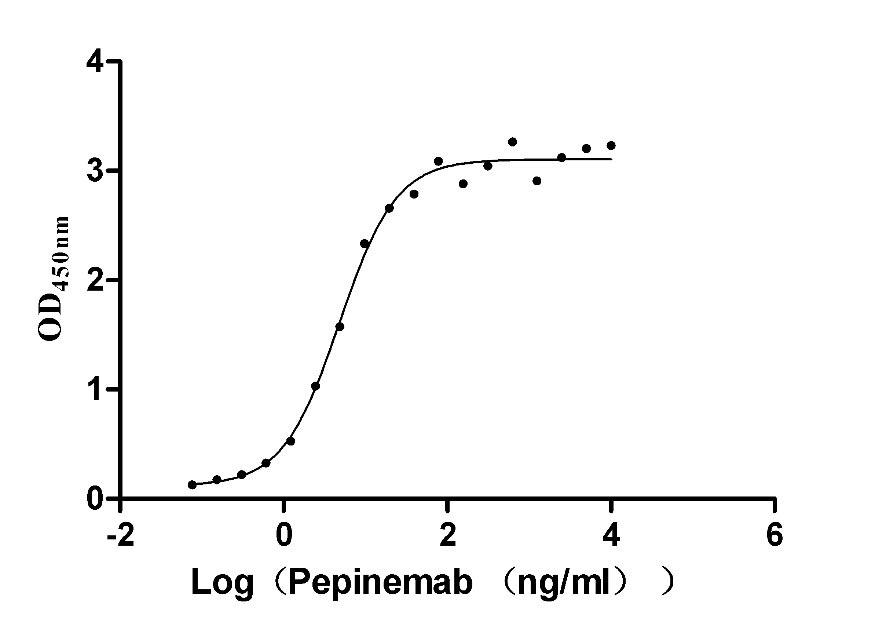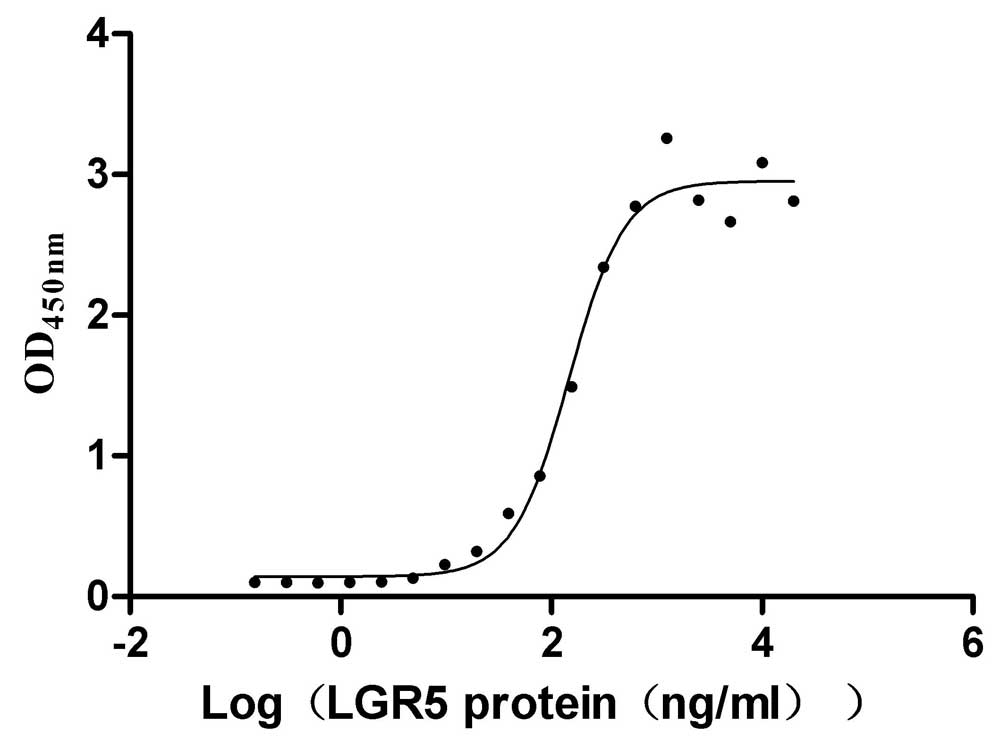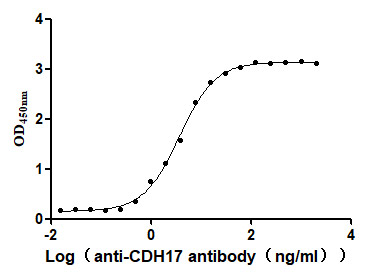Recombinant Human Sterol regulatory element-binding protein 2 (SREBF2), partial
-
中文名稱:人SREBF2重組蛋白
-
貨號:CSB-YP621515HU1
-
規格:
-
來源:Yeast
-
其他:
-
中文名稱:人SREBF2重組蛋白
-
貨號:CSB-EP621515HU1
-
規格:
-
來源:E.coli
-
其他:
-
中文名稱:人SREBF2重組蛋白
-
貨號:CSB-EP621515HU1-B
-
規格:
-
來源:E.coli
-
共軛:Avi-tag Biotinylated
E. coli biotin ligase (BirA) is highly specific in covalently attaching biotin to the 15 amino acid AviTag peptide. This recombinant protein was biotinylated in vivo by AviTag-BirA technology, which method is BriA catalyzes amide linkage between the biotin and the specific lysine of the AviTag.
-
其他:
-
中文名稱:人SREBF2重組蛋白
-
貨號:CSB-BP621515HU1
-
規格:
-
來源:Baculovirus
-
其他:
-
中文名稱:人SREBF2重組蛋白
-
貨號:CSB-MP621515HU1
-
規格:
-
來源:Mammalian cell
-
其他:
產品詳情
-
純度:>85% (SDS-PAGE)
-
基因名:
-
Uniprot No.:
-
別名:SREBF2; BHLHD2; SREBP2; Sterol regulatory element-binding protein 2; SREBP-2; Class D basic helix-loop-helix protein 2; bHLHd2; Sterol regulatory element-binding transcription factor 2
-
種屬:Homo sapiens (Human)
-
蛋白長度:Partial
-
蛋白標簽:Tag?type?will?be?determined?during?the?manufacturing?process.
The tag type will be determined during production process. If you have specified tag type, please tell us and we will develop the specified tag preferentially. -
產品提供形式:Lyophilized powder
Note: We will preferentially ship the format that we have in stock, however, if you have any special requirement for the format, please remark your requirement when placing the order, we will prepare according to your demand. -
復溶:We recommend that this vial be briefly centrifuged prior to opening to bring the contents to the bottom. Please reconstitute protein in deionized sterile water to a concentration of 0.1-1.0 mg/mL.We recommend to add 5-50% of glycerol (final concentration) and aliquot for long-term storage at -20℃/-80℃. Our default final concentration of glycerol is 50%. Customers could use it as reference.
-
儲存條件:Store at -20°C/-80°C upon receipt, aliquoting is necessary for mutiple use. Avoid repeated freeze-thaw cycles.
-
保質期:The shelf life is related to many factors, storage state, buffer ingredients, storage temperature and the stability of the protein itself.
Generally, the shelf life of liquid form is 6 months at -20°C/-80°C. The shelf life of lyophilized form is 12 months at -20°C/-80°C. -
貨期:Delivery time may differ from different purchasing way or location, please kindly consult your local distributors for specific delivery time.Note: All of our proteins are default shipped with normal blue ice packs, if you request to ship with dry ice, please communicate with us in advance and extra fees will be charged.
-
注意事項:Repeated freezing and thawing is not recommended. Store working aliquots at 4°C for up to one week.
-
Datasheet :Please contact us to get it.
相關產品
靶點詳情
-
功能:Precursor of the transcription factor form (Processed sterol regulatory element-binding protein 2), which is embedded in the endoplasmic reticulum membrane. Low sterol concentrations promote processing of this form, releasing the transcription factor form that translocates into the nucleus and activates transcription of genes involved in cholesterol biosynthesis.; Key transcription factor that regulates expression of genes involved in cholesterol biosynthesis. Binds to the sterol regulatory element 1 (SRE-1) (5'-ATCACCCCAC-3'). Has dual sequence specificity binding to both an E-box motif (5'-ATCACGTGA-3') and to SRE-1 (5'-ATCACCCCAC-3'). Regulates transcription of genes related to cholesterol synthesis pathway.
-
基因功能參考文獻:
- SREBF2 polymorphism rs2269657 showed significant dual associations with LOAD pathological biomarkers and gene expression levels. Furthermore, SREBF2 expression levels measured in LOAD frontal cortices inversely correlated with age at death; suggesting a possible influence on survival rate. PMID: 29503034
- SREBP-2 regulates autophagy-related gene expression in human liver cells. PMID: 29336468
- High SREBP-2 expression is associated with hypercholesterolemia. PMID: 29678744
- By altering the membrane trafficking through the lysosomes, cholesterol redistributes and regulates SREBP-2. PMID: 28696297
- The gene polymorphism of SREBP2 not only significantly associated with the clinical phenotypes of osteonecrosis of the femoral head but also closely related to lipid metabolism disorder. PMID: 28901487
- The current investigation indicated that the rs2267439C/T polymorphism in the SREBF-2 gene increased the T2D susceptibility in an Iranian population. PMID: 29601949
- Hexacosanol activates AMPK and hepatic autophagy and inhibits SREBP2, resulting in hypocholesterolemic activities and improvement of hepatic steatosis. PMID: 28676202
- CpG sites located in SREBF2 gene showed differential methylation in association with total cholesterol. The expression of the SREBF2 was inversely associated with methylation of its corresponding CpGs. PMID: 28173150
- Acidic pH-responsive SREBP2 target genes were associated with reduced overall survival of cancer patients. PMID: 28249167
- these clinical and experimental results reveal a novel role of SREBP-2 in the induction of a stem cell-like phenotype and prostate cancer metastasis PMID: 26883200
- These results seem to suggest an involvement of SREBF-2 in the integrity of white matter tracts in bipolar disorder and therefore a possible role of SREBP pathway in CNS myelination processes. PMID: 27771555
- High expression of SREBF2 is associated with high carotid intima-media thickness. PMID: 27841945
- mechanistic investigation provides clinical insights into protective roles of the epithelial cholesterol deficiency against excessive inflammatory responses via the SREBP2-HuR circuit, although the deficiency triggers transient pro-inflammatory signals. PMID: 27703009
- Dietary flavones counteract phorbol 12-myristate 13-acetate-induced SREBP-2 processing in hepatic cells. PMID: 27778136
- Identify a novel signaling pathway in hepatocytes triggered by ligand-activated p75NTR that via p38 MAPK and caspase-3 mediate the activation of SREBP2. This pathway may regulate LDLRs and lipid uptake particularly after injury or during tissue inflammation accompanied by an increased production of growth factors, including NGF and pro-NGF. PMID: 26984409
- The connections of EGFR and ERBB4 signaling with SREBP-2-regulated cholesterol metabolism are likely to be important in ERBB-regulated developmental processes and may contribute to metabolic remodeling in ERBB-driven cancers. PMID: 26535009
- knockdown of endogenous SREBP2 in HepG2 cells lowered ACSL1 mRNA and protein levels. PMID: 26728456
- Data suggest lysophosphatidylcholine (LPC) up-regulates SREBP-2 and cholesterol efflux in vascular endothelium; 25-hydroxycholesterol (25-HC) inhibits these effects of LPC; both LPC and 25-HC up-regulate release of interleukin-6 and interleukin-8. PMID: 25998247
- the results of the present study showed that luteolin modulates HMGCR transcription by decreasing the expression and nuclear translocation of SREBP-2. PMID: 26302339
- HCV core protein disturbs the cholesterol homeostasis in HepG2 cells via the SREBP2 pathway; miR-185-5p is involved in the regulation of SREBP2 by the core protein. PMID: 25914460
- the 5-aminoimidazole-4-carboxyamide ribonucleoside (AICAR)-induced activation of AMPK directly inhibited the expression of SREBP-2 and HMGCR and HMGCS, and suppressed the TSH-stimulated up-regulation of SREBP-2 in HepG2 cells. PMID: 25933205
- Suggest important role for SREBP-2 in regulation of lipid and glucose metabolism in hypertensive rats. PMID: 24908080
- Our results show that though leptin stimulates LDLR expression very weakly through JAK-STAT signaling pathway, it mainly imposes inhibition on LDLR expression by inhibiting transcription factor SREBP2 PMID: 25488447
- The results of this study suggested that the genetic polymorphisms of SREBF2 gene may be associated with metabolic syndrome in patients treated with clozapine. PMID: 25201120
- SREBP-2 rs2228314 G to C change and variant C genotype as well as LXRalpha rs11039155 G to A change and variant A may contribute to PCOS in Chinese Han population PMID: 25005769
- The SREBP-induced NOD-like receptor family pyrin domain-containing protein inflammasome and its instigation of innate immunity is an important contributor to atherosclerosis. PMID: 25188917
- The results of this study provide evidence that the GG genotype and G carrier (CG+GG) of rs2228314 G>C polymorphism in the SREBP-2 gene may increase the risk of NAFLD. PMID: 24992162
- findings suggest that SREBP2-miR-92a-inflammasome exacerbates endothelial dysfunction during oxidative stress PMID: 25550450
- SREBP-2 rs2228314 G to C change and variant C genotype may contribute to knee osteoarthritis risk in a Chinese Han population. PMID: 24496149
- Data show that forkhead transcription factor 4 (FoxO4) interacts with sterol regulatory element binding protein (SREBP)2 and hypoxia inducible factor (HIF)2alpha to modulate lanosterol 14alpha demethylase (CYP51) promoter activity. PMID: 24353279
- Rating SREBF2 polymorphism did not reveal a relationship to the occurrence of ischemic heart disease in patients with obstructive sleep apnea, both in the whole group as well as separate subgroups. PMID: 24868893
- A single nucleotide polymorphism that tags both the XRCC6 and SREBF2 genes strongly modifies the association between bladder cancer risk and smoking PMID: 24382701
- SREBP cleavage regulates Golgi-to-endoplasmic reticulum recycling of SREBP cleavage-activating protein (SCAP) PMID: 24478315
- These results suggest that SREBP-2 negatively regulates the FXR-mediated transcriptional activation of the FGF19 gene in human intestinal cells. PMID: 24321096
- Results suggested that interaction of SREBP-2 gene polymorphisms and the relationship between the polymorphisms and clinical phenotype of IGFBP-3 were closely related to increased ANFH risk in the Chinese population. PMID: 23158139
- Atheroprone flow induces NLRP3 inflammasome in endothelium through SREBP2 activation. PMID: 23838163
- Data indicate that SREBP-2 and Scap are regulated by factors driving prostate growth, and suggest exploring this observation further could shed light on prostate carcinogenesis. PMID: 23454642
- Starvation regulates endothelial lipase expression via SREBP-2. PMID: 23102786
- RNAi-mediated inhibition of SREBP2 expression significantly ameliorated the cholesterol accumulation induced by inflammatory cytokines in HepG2 cells. PMID: 23044239
- Results demonstrated, for the first time, the association of SREBP-2 with osteoarthritis pathogenesis and provided evidence on the molecular mechanism involved. PMID: 22662110
- Endoplasmic reticulum stress-induced SREBP-2 activation contributes to renal proximal tubule cell injury by dysregulating lipid homeostasis. PMID: 22573382
- SREBP-2 is directly linked as a target of amyloid-beta protein in cholesterol homeostasis impairment. PMID: 22573671
- SREBP-2 1784 G/C polymorphism is associated with non-alcoholic fatty liver disease in Asian Indians in north India. PMID: 22182810
- Linalool reduces the expression of 3-hydroxy-3-methylglutaryl CoA reductase via sterol regulatory element binding protein-2- and ubiquitin-dependent mechanisms. PMID: 21944868
- A combination oral contraceptive maintained a high-profile expression of LDLR through the stimulation of its transcription factor SREBP2 in primary placental trophoblasts and Jar cell line. PMID: 21757058
- could not identify any association between SREBF-2 1784G > C or SCAP 2386A > G SNPs and premature coronary artery disease or extent of coronary lesions in a Chinese population. PMID: 20111910
- results demonstrate for the first time that HIV-1 transcription in T cells is linked to cholesterol homeostasis through control of TFII-I expression by SREBP2 PMID: 21613400
- hepatic NPC1L1 in the liver from Chinese female gallstone patients may be mediated by SREBP2 PMID: 20144195
- miR-33 expression from an SREBP2 intron inhibits cholesterol export and fatty acid oxidation PMID: 20732877
- Data show that miR-33 is encoded within SREBP-2 and that both mRNAs are coexpressed. PMID: 20566875
顯示更多
收起更多
-
亞細胞定位:[Sterol regulatory element-binding protein 2]: Endoplasmic reticulum membrane; Multi-pass membrane protein. Golgi apparatus membrane; Multi-pass membrane protein. Cytoplasmic vesicle, COPII-coated vesicle membrane; Multi-pass membrane protein.; [Processed sterol regulatory element-binding protein 2]: Nucleus.
-
蛋白家族:SREBP family
-
組織特異性:Ubiquitously expressed in adult and fetal tissues.
-
數據庫鏈接:
Most popular with customers
-
Recombinant Human Semaphorin-4D (SEMA4D), partial (Active)
Express system: Mammalian cell
Species: Homo sapiens (Human)
-
Recombinant Macaca fascicularis Delta-like protein 3 (DLL3), partial (Active)
Express system: Mammalian cell
Species: Macaca fascicularis (Crab-eating macaque) (Cynomolgus monkey)
-
Recombinant Human R-spondin-1 (RSPO1), partial (Active)
Express system: Mammalian cell
Species: Homo sapiens (Human)
-
Recombinant Mouse Transthyretin (Ttr) (Active)
Express system: Mammalian cell
Species: Mus musculus (Mouse)
-
Recombinant Human Microtubule-associated protein tau (MAPT) (Active)
Express system: Mammalian cell
Species: Homo sapiens (Human)
-
Recombinant Human Cadherin-17 (CDH17), partial (Active)
Express system: Mammalian cell
Species: Homo sapiens (Human)
-
Recombinant Human B- and T-lymphocyte attenuator(BTLA), partial (Active)
Express system: Mammalian cell
Species: Homo sapiens (Human)






-AC1.jpg)











